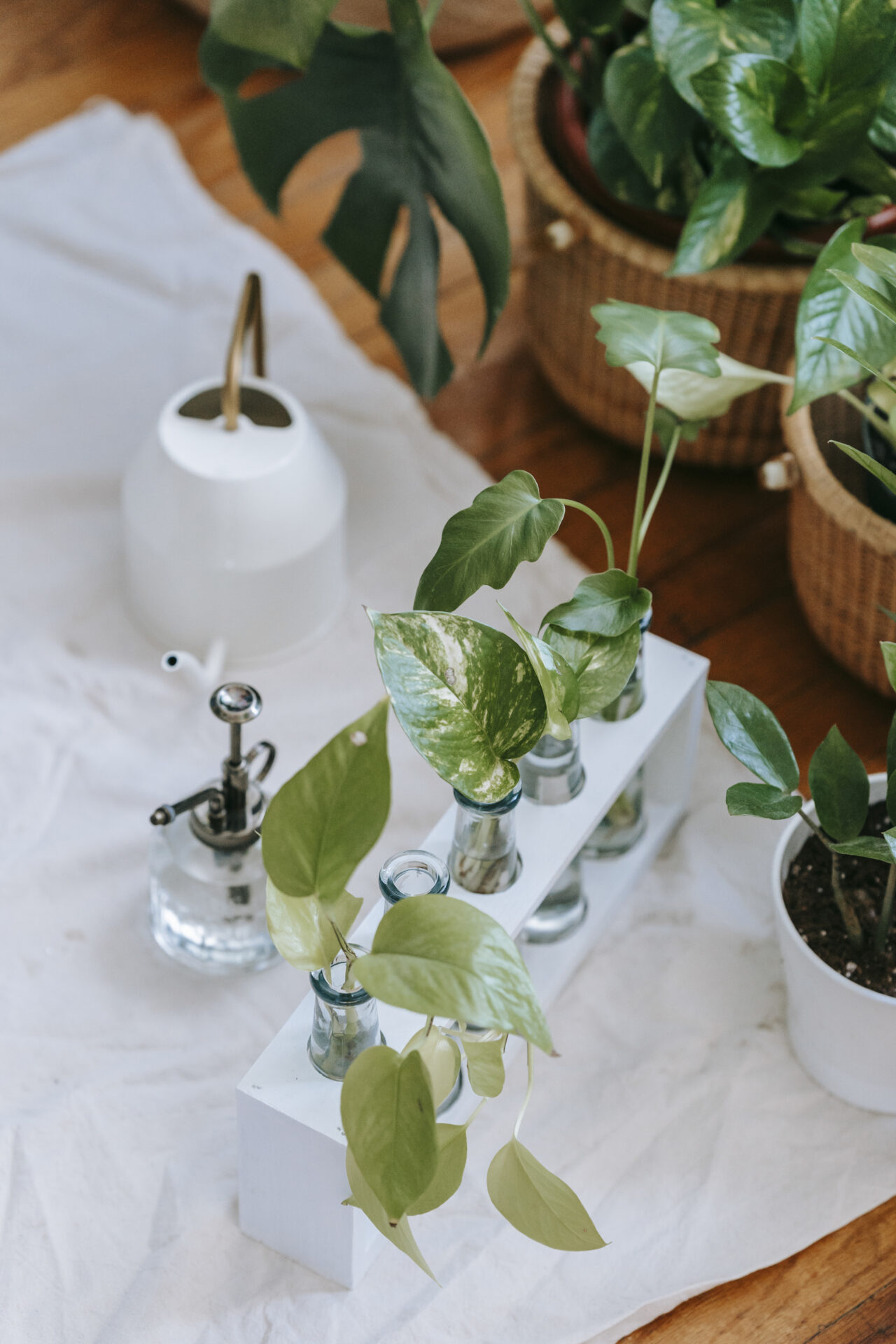Indoor air quality has become an increasingly important aspect of our lives as we spend most of our time indoors. With the growing concern about air pollution and its adverse impacts on human health, finding solutions to improve indoor air quality is essential.
One such innovative solution is indoor vertical gardening, which optimizes space utilization and purifies the air within our homes and workplaces. In this article, we will delve into the core principles of indoor vertical gardening and its impact on indoor air quality.
We will explore the benefits of incorporating these living walls into our daily environments and discuss the scientific evidence supporting indoor plants’ role in reducing airborne pollutants, improving air circulation, and enhancing our overall well-being. Join us as we investigate the transformative potential of indoor vertical gardening in creating healthier and more sustainable living spaces.
Role of Indoor Vertical Gardens in Air Purification
Indoor vertical gardens offer many benefits, one of which is their significant role in air purification. These living walls actively filter and cleanse the air within our living and working spaces, contributing to a healthier environment. In this subsection, we will discuss the various aspects of how indoor vertical gardens purify the air and what makes them an essential addition to modern architectural designs.
The Science Behind Air Purification by Indoor Plants
Indoor plants can naturally absorb airborne pollutants and volatile organic compounds (VOCs) through phytoremediation. When plants take in contaminated air through their stomata, they break down and neutralize harmful substances, releasing cleaner air into the environment. Vertical gardens, with their high density of plants, create an even more efficient system for air purification, maximizing the benefits of phytoremediation.
Removing Common Indoor Air Pollutants
Indoor vertical gardens effectively remove various common air pollutants such as formaldehyde, benzene, and trichloroethylene. These pollutants are commonly found in household products and building materials, and prolonged exposure can lead to adverse health effects. By incorporating plants with a high capacity for air purification, indoor vertical gardens serve as a natural and cost-effective method for improving air quality.
Enhanced Air Circulation and Humidity Regulation
In addition to air purification, indoor vertical gardens contribute to better air circulation and humidity regulation. The plants in a vertical garden transpire moisture, increasing humidity levels in the surrounding environment, which can help alleviate symptoms of dry skin, allergies, and respiratory issues. Moreover, the natural airflow created by the plants aids in distributing the purified air throughout the space, providing a more comfortable and healthier indoor environment.
Incorporating Vertical Gardens in Modern Architectural Designs
Due to their numerous benefits and aesthetic appeal, indoor vertical gardens have become increasingly popular in modern architectural designs. They have been integrated into various spaces such as homes, offices, and public buildings, transforming these areas into greener, healthier, and more sustainable environments. To learn more about the role of indoor vertical gardens in modern architecture, check out this article: The Role of Indoor Vertical Gardens in Modern Architecture.
As we have seen, indoor vertical gardens play a crucial role in air purification, making them a valuable addition to any living or working space. Integrating these living walls into our environments can create healthier, more sustainable spaces that contribute to our overall well-being.
Types of Air-Purifying Plants for Vertical Gardens
Incorporating air-purifying plants in indoor vertical gardens can significantly enhance the air quality within our living and working spaces. As previously mentioned, these plants can absorb and neutralize harmful pollutants in the air through a process called phytoremediation. In this subsection,
we will discuss various types of air-purifying plants suitable for vertical gardens and the specific pollutants they can help eliminate. By carefully selecting the right combination of plants, you can create a thriving, visually appealing, and efficient air-purifying vertical garden for your home or office.
Spider Plant (Chlorophytum comosum)
The spider plant is an excellent choice for an air-purifying vertical garden. It is known to remove pollutants such as formaldehyde, benzene, and carbon monoxide. In addition to its air-purifying capabilities, the spider plant is low-maintenance. It can adapt to various indoor conditions, making it a popular choice for novice and experienced gardeners.
Snake Plant (Sansevieria trifasciata)
Also referred to as Mother-in-Law’s Tongue, the snake plant is another effective air-purifying plant suitable for vertical gardens. It is particularly efficient at removing benzene, formaldehyde, trichloroethylene, and xylene from the air. Furthermore, snake plants release oxygen at night, which can help improve the air quality in your bedroom while you sleep. They are also low-maintenance and can thrive in various lighting conditions.
Golden Pothos (Epipremnum aureum)
Golden pothos, also known as Devil’s Ivy, is a versatile air-purifying plant that can be easily incorporated into vertical gardens. It effectively eliminates pollutants such as formaldehyde, benzene, and xylene. Golden pothos is a fast-growing plant that can quickly cover a vertical garden structure, providing a lush and attractive appearance. It is also easy to care for, making it an ideal choice for those new to indoor gardening.
Peace Lily (Spathiphyllum spp.)
The peace lily is a beautiful flowering plant that is visually appealing and effective in removing harmful indoor pollutants. It is particularly efficient at eliminating formaldehyde, benzene, and ammonia from the air. Peace lilies prefer indirect sunlight and require moderate watering, making them suitable for indoor vertical gardens.
Boston Fern (Nephrolepis exaltata)
Boston ferns, with their delicate, arching fronds, are an attractive addition to any indoor vertical garden. They are particularly effective at removing formaldehyde and xylene from the air. Boston ferns thrive in humid environments and require consistent moisture, making them a fitting choice for bathrooms or other spaces with higher humidity levels.
Selecting the right combination of air-purifying plants for your indoor vertical garden can significantly improve the air quality within your space. By considering the specific pollutants you want to target and the environmental conditions of your chosen location, you can create a thriving, visually appealing, and efficient air-purifying vertical garden that contributes to a healthier and more sustainable indoor environment.
Understanding Indoor Air Pollution Sources
Indoor air pollution is a significant concern for the health and well-being of individuals residing or working in enclosed spaces. Recognizing the various sources of indoor air pollution is essential to effectively combat its adverse effects on human health. In this subsection, we will delve into the familiar sources of indoor air pollution and discuss how indoor vertical gardens can mitigate these pollutants, thus improving indoor air quality.
Building Materials and Household Products
Many building materials, such as paints, adhesives, and pressed wood products, release volatile organic compounds (VOCs) that can harm indoor air quality. Other everyday household products, including cleaning solutions, air fresheners, and personal care products, also emit VOCs that contribute to indoor pollution. Indoor vertical gardens can help neutralize these VOCs by absorbing and breaking them down, providing cleaner and healthier air within the space.
Combustion Sources and Tobacco Smoke
Combustion sources, such as gas stoves, fireplaces, and heating systems, produce harmful pollutants like carbon monoxide, nitrogen dioxide, and particulate matter. Tobacco smoke, which contains thousands of toxic chemicals, is another significant contributor to indoor air pollution. Incorporating air-purifying plants in indoor vertical gardens can significantly reduce these harmful pollutants, contributing to a healthier indoor environment.
Mold and Mildew
Mold and mildew thrive in damp and humid conditions, releasing spores and mycotoxins that can negatively impact indoor air quality and cause respiratory problems. When properly maintained, indoor vertical gardens can help regulate humidity levels, reducing the likelihood of mold growth. Additionally, some plants, such as the Boston fern, have properties that can help inhibit the growth of mold and mildew, making them a valuable addition to indoor vertical gardens.
Pet Dander and Dust Mites
Pet dander and dust mites are common allergens found in most indoor environments. They contribute to poor indoor air quality and cause allergic reactions in sensitive individuals. Indoor vertical gardens can capture and filter these allergens, providing relief for allergy sufferers and improving the overall air quality within the space.
Outdoor Air Pollutants
Outdoor air pollutants, such as particulate matter and ozone, can also infiltrate indoor spaces, especially in urban areas with high traffic and industrial activity levels. Indoor vertical gardens are a natural barrier against these outdoor pollutants, filtering and neutralizing them before they can negatively impact the indoor air quality.
By identifying the sources of indoor air pollution and incorporating indoor vertical gardens into our living and working spaces, we can effectively combat these pollutants and create a healthier, more sustainable environment. With a carefully curated selection of air-purifying plants, indoor vertical gardens offer a visually appealing and efficient solution to improving indoor air quality and enhancing our overall well-being.
Benefits of Improved Indoor Air Quality
Indoor vertical gardens contribute to better indoor air quality by filtering out harmful pollutants and maintaining optimal humidity levels in our living and working spaces. Improved indoor air quality has numerous health benefits, enhancing our overall well-being and quality of life. In this subsection, we will delve into the advantages of having cleaner air in our indoor environments, highlighting the importance of incorporating vertical gardens into our daily lives.
Reduced Respiratory Issues and Allergy Symptoms
One of the most notable benefits of improved indoor air quality is reducing respiratory issues and allergy symptoms. Cleaner air, free of allergens and pollutants, minimizes the risk of respiratory infections, asthma, and other respiratory problems. Individuals with allergies also experience relief from symptoms such as sneezing, watery eyes, and congestion, as indoor vertical gardens help filter out common allergens like pet dander and dust mites.
Enhanced Cognitive Function and Productivity
Improved indoor air quality has been linked to enhanced cognitive function and increased productivity. Studies have shown that cleaner air can lead to better concentration, memory, and decision-making abilities, resulting in higher productivity levels, particularly in office environments. By incorporating indoor vertical gardens into workspaces, employers can create healthier environments that support the well-being and efficiency of their employees.
Boosted Mood and Mental Health
Plants in indoor spaces have been associated with positive effects on mood and mental health. With their lush greenery, indoor vertical gardens create a calming atmosphere that can help reduce stress, anxiety, and depression. In addition, the improved air quality provided by these living walls contributes to a sense of well-being and comfort, further enhancing our emotional health.
Lowered Risk of Chronic Health Conditions
Long-term exposure to indoor air pollution has been linked to the development of chronic health conditions, such as heart disease, stroke, and even certain types of cancer. Improving indoor air quality through indoor vertical gardens can mitigate these risks and create a healthier environment for ourselves and our loved ones.
Increased Energy Levels and Sleep Quality
Cleaner air can also lead to increased energy levels and improved sleep quality. Breathing in fresh, purified air reduces fatigue and increases oxygen supply to our bodies, resulting in higher energy levels during the day. Plants such as the snake release oxygen at night, contributing to a better night’s sleep and overall restfulness.
Improved indoor air quality has far-reaching benefits, from enhancing physical health to supporting mental well-being and productivity. Indoor vertical gardens provide an efficient and visually appealing solution to achieving cleaner air in our living and working spaces. By embracing these living walls as an integral part of our indoor environments, we can create a healthier, more sustainable, and enjoyable atmosphere that fosters our overall well-being.
Design Tips for Effective Air-Purifying Vertical Gardens
Creating a practical air-purifying vertical garden requires thoughtful planning and design to maximize its potential for improving indoor air quality. In this subsection, we will explore various design tips and considerations to help you create a visually appealing and efficient vertical garden that can significantly enhance the air quality within your space. By following these guidelines, you can ensure that your indoor vertical garden adds aesthetic value to your home or office and serves as a powerful tool for air purification and overall well-being.
Choose the Right Plant Species
Selecting the appropriate plant species for your air-purifying vertical garden is crucial in achieving optimal results. As discussed earlier in this article, certain plants are particularly efficient at removing specific pollutants from the air. Choosing a mix of plants that can target various pollutants commonly found in indoor environments is essential. Some popular air-purifying plants include spiders, snakes, golden pothos, peace lilies, and Boston ferns. Additionally, consider each plant’s lighting and humidity requirements to ensure that they will thrive in the chosen location for your vertical garden.
Optimize Plant Density and Arrangement
Plant density and arrangement play a significant role in the effectiveness of your vertical garden’s air-purifying capabilities. A higher density of plants will provide a larger surface area for pollutant absorption and transpiration, resulting in more efficient air purification. Be mindful of the growth habits of each plant species, and arrange them in a way that allows for proper airflow and exposure to light. This will ensure that your plants remain healthy and continue to contribute to improved air quality.
Consider the Vertical Garden Structure
The structure of your vertical garden is another essential factor to consider when designing an air-purifying vertical garden. Select a structure that allows for adequate plant support, drainage, and aeration. Various vertical garden systems are available, such as modular panels, pocket planters, and trellises, each with its own advantages and limitations. Choose a system that aligns with your space, budget, and maintenance preferences while ensuring the well-being of your plants.
Integrate Efficient Irrigation and Drainage Systems
Proper irrigation and drainage are crucial to the health and success of your air-purifying vertical garden. An efficient irrigation system will ensure that your plants receive adequate water without over-saturation, which can lead to root rot and mold growth. Drip irrigation systems or self-watering planters are popular for vertical gardens, providing consistent moisture without wasting water. Additionally, ensure that your vertical garden structure allows for proper drainage, preventing excess moisture accumulation that could harm your plants and the surrounding environment.
Maintain Your Vertical Garden Regularly
Regular maintenance is vital for the longevity and effectiveness of your air-purifying vertical garden. Monitor your plants for signs of pests, diseases, or nutrient deficiencies, and address any issues promptly to ensure the continued health of your garden. Prune and trim your plants to maintain proper airflow and light exposure, and replace any plants that may not thrive in their current environment. By diligently caring for your vertical garden, you can ensure that it remains an attractive and efficient tool for improving indoor air quality.
By following these design tips and considerations, you can create a successful air-purifying vertical garden that enhances the aesthetics of your indoor space and significantly improves its air quality. With careful planning and attention to detail, your indoor vertical garden can serve as a valuable asset in creating a healthier, more sustainable, and enjoyable environment for you and your loved ones.







Leave a reply